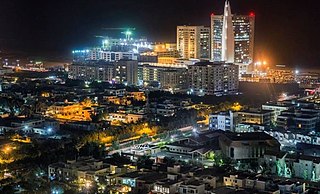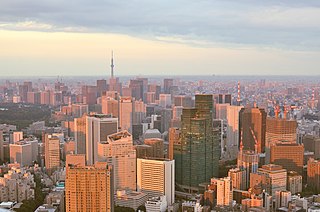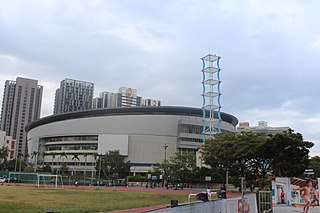
The economy of Pakistan is the 23rd largest in the world in terms of purchasing power parity (PPP), and 38th largest in terms of nominal gross domestic product. Pakistan has a population of over 207 million, giving it a nominal GDP per capita of $1,641 in 2018, which ranks 147th in the world and giving it s PPP GDP per capita of 5,709 in 2018, which ranks 130th in the world for 2018. However, Pakistan's undocumented economy is estimated to be 36% of its overall economy, which is not taken into consideration when calculating per capita income. Pakistan is a developing country and is one of the Next Eleven countries identified by Jim O'Neill in a research paper as having a high potential of becoming, along with the BRICS countries, among the world's largest economies in the 21st century. The economy is semi-industrialized, with centres of growth along the Indus River. Primary export commodities include textiles, leather goods, sports goods, chemicals, carpets/rugs and medical instruments.

Paraguay has a market economy highly dependent on agriculture products. In recent years, the economy has grown as a result of increased agricultural exports, especially soybeans. Paraguay has the economic advantages of a young population and vast hydroelectric power but has few mineral resources, and political instability has undercut some of the economic advantages present. The government welcomes foreign investment.

The economy of South Korea is the 4th largest in Asia and the 11th largest in the world. It is a mixed economy dominated by family-owned conglomerates called chaebols; however, the dominance of the chaebol is unlikely to last and engenders risk of slowing down the transformation of Korean economy for the benefit of future generations. South Korea is known for its spectacular rise from one of the poorest countries in the world to a developed, high-income country in just a few generations. This economic growth is called by some a miracle, and described as the Miracle on the Han River, which has brought South Korea to the ranks of elite countries in the OECD and the G-20. South Korea still remains one of the fastest growing developed countries in the world following the Great Recession. It is included in the group of Next Eleven countries that will dominate the global economy in the middle of the 21st century.

The national economy of Taiwan, is the 7th largest economy in Asia, and is included in the advanced economies group by the International Monetary Fund and gauged in the high-income economies group by the World Bank, and ranked 15th in the world by the Global Competitiveness Report of World Economic Forum, has a developed capitalist economy that ranks as the 22nd-largest in the world by purchasing power parity (PPP), ranks as 18th in the world by gross domestic product (GDP) at purchasing power parity per capita (person), and 24th in nominal GDP of investment and foreign trade by the Republic of China (Taiwan) government, commonly referred to as Taiwan. As of 2018, telecommunication, financial services and utility services are three highest individuals paid sectors in Taiwan. The economy of Taiwan ranks the highest in Asia for 2015 Global Entrepreneurship Index (GEI) for specific strengths. Most large government-owned banks and industrial firms have been privatized, and now family owned businesses are the streamlined economic factors in Taiwan. With the technocracy-centered economic planning under martial law until 1987, real growth in GDP has averaged about 8% during the past three decades. Exports have grown even faster and since World War II, have provided the primary impetus for industrialization. Inflation and unemployment are low; the trade surplus is substantial; and foreign reserves are the world's fourth largest. Agriculture contributes 3% to GDP, down from 35% in 1952, and the service sector makes up 73% of the economy. Traditional labor-intensive industries are steadily being moved off-shore and replaced with more capital- and technology-intensive industries in the pre-mature stage of the manufacturing industry in the global economic competitions on labor cost, automation, product design realization (prototype), technology commercialization, scientific materialization (patent), scientific discovery, and growing from the over-reliance from the original equipment manufacturer and original design manufacturer models, in which there is no single University from Taiwan entering Reuter's Global Top Innovative 100 University ranking, and the economy of Taiwan may need international collaboration on University, Research and Industrial cooperation on spin-off opportunities. Economy of Taiwan is an indispensable partner in the Global Value Chains of Electronics Industry. Electronic components and personal computer are two areas of international strength of Taiwan's Information Technology industry, which means the economy of Taiwan has the competitive edge on having the learning curve from advanced foreign technologies with lower cost to be produced and sold abroad. Institute for Information Industry with its international recognitions is responsible for the development of IT industry and ICT industry in Taiwan. Industrial Technology Research Institute with its global partners is the advanced research center for applied technology for the economy of Taiwan. Directorate-General of Budget, Accounting and Statistics and Ministry of Economic Affairs release major economic indicators of the economy of Taiwan. Chung-Hua Institution for Economic Research provides economic forecast at the forefront for the economy of Taiwan and authoritatively researches on the bilateral economic relations with ASEAN by The Taiwan ASEAN Studies Center (TASC). Taiwan Stock Exchange is the host to the listed companies of local industries in Taiwan with weighted financial exposures to the FTSE Taiwan Index and MSCI Taiwan Index.

The economy of the United Arab Emirates is the second largest in the Middle East, with a gross domestic product (GDP) of $403.2 billion in 2014. The Emirates have been successfully diversifying their economy.

The socialist-oriented market economy of the Socialist Republic of Vietnam is the 47th-largest economy in the world measured by nominal gross domestic product (GDP) and 35th-largest in the world measured by purchasing power parity (PPP). The country is a member of Asia-Pacific Economic Cooperation, Association of Southeast Asian Nations and the World Trade Organization.

Shih Chien University is a private university in Taiwan. It has two campuses: one in Dazhi, Zhongshan District, Taipei and the other in Neimen District, Kaohsiung. Its professional performance and courses in design has been regarded in the '60 top D-schools in the world' by BusinessWeek in 2006. Its Master in Industrial Design program was selected into "the best 30 design programs" in the world by BusinessWeek in 2009.

The economy of Asia comprises more than 4.5 billion people living in 49 different nation states. Six further states lie partly in Asia, but are considered to belong to another region economically and politically. Asia is the fastest growing economic region, as well as the largest continental economy by both GDP Nominal and PPP in the world. China, Japan, India, South Korea and Indonesia are currently the top five economies in Asia. Moreover, Asia is the site of some of the world's longest modern economic booms, starting from the Japanese economic miracle (1950–1990), Miracle on the Han River (1961–1996) in South Korea, economic boom (1978–2013) in China and economic boom in India (1991–present).

The economy of India is a developing mixed economy. It is the world's seventh-largest economy by nominal GDP and the third-largest by purchasing power parity (PPP). The country ranks 139th in per capita GDP (nominal) with $2,134 and 122nd in per capita GDP (PPP) with $7,783 as of 2018. After the 1991 economic liberalisation, India achieved 6-7% average GDP growth annually. Since 2014 with the exception of 2017, India's economy has been the world's fastest growing major economy, surpassing China.
In its economic relations, Japan is both a major trading nation and one of the largest international investors in the world. In many respects, international trade is the lifeblood of Japan's economy. Imports and exports totaling the equivalent of nearly US$1.309.2 Trillion in 2017, which meant that Japan was the world's fourth largest trading nation after the China, United States and Germany. Trade was once the primary form of Japan's international economic relationships, but in the 1980s its rapidly rising foreign investments added a new and increasingly important dimension, broadening the horizons of Japanese businesses and giving Japan new world prominence.
The Taiwan Miracle or Taiwan Economic Miracle refers to the rapid industrialization and economic growth of Taiwan during the latter half of the twentieth century. As it has developed alongside Singapore, South Korea and Hong Kong, Taiwan became known as one of the "Four Asian Tigers".

Foreign direct investment in Iran (FDI) has been hindered by unfavorable or complex operating requirements and by international sanctions, although in the early 2000s the Iranian government liberalized investment regulations. Iran ranks 62nd in the World Economic Forum's 2011 analysis of the global competitiveness of 142 countries. In 2010, Iran ranked sixth globally in attracting foreign investments.
The electronics industry in China grew rapidly after the liberalization of the economy under the national strategic policy of accelerating the "informatization" of its industrial development.

The Economy of East Asia comprises more than 1.6 billion people living in 6 different countries. East Asia is home to one of the most economically dynamic places in the world. The region is the site to some of the world's longest modern economic booms, starting from the Japanese economic miracle (1950–1990), Miracle on the Han River (1961–1996) in South Korea, the Taiwan miracle in Taiwan (1960–1996) and the economic boom (1978–2015) in Mainland China. The region is home of some of the world's largest and most prosperous economies: Mainland China, Hong Kong, Macau, Japan, South Korea, and Taiwan. As East Asia's economic prominence has grown, so has its importance and influence in the world economy. It has emerged as an increasingly prominent region in the Asian continent and in the global economy and international politics as a whole. East Asia now boasts an expanding cosmopolitan middle class, where its members are linked to the global communications grid that are identifying with its Western counterparts across the world making it a significant force to be reckoned with in the global economy. The region's economic success has led to it being dubbed "An East Asian renaissance" by the World Bank in 2007.

The socialist market economy of the People's Republic of China is the world's second largest economy by nominal GDP and the world's largest economy by purchasing power parity. Until 2015, China was the world's fastest-growing major economy, with growth rates averaging 6% over 30 years. Due to historical and political facts of China's developing economy, China's public sector accounts for a bigger share of the national economy than the burgeoning private sector. According to the IMF, on a per capita income basis China ranked 71st by GDP (nominal) and 78th by GDP (PPP) per capita in 2016. The country has an estimated $23 trillion worth of natural resources, 90% of which are coal and rare earth metals. China also has the world's largest total banking sector assets of $39.9 trillion with $26.54 trillion in total deposits.
The economy of Dalian plays an important part in Northeast China and Northeast Asia.

Relations between the European Union (EU) and Japan date back to 1959. They have a strong trade relationship, particularly in investment flows.
The textile industry in China is the largest in the world in both overall production and exports. China exported $274 billion in textiles in 2013, a volume that was nearly seven times that of India, the second largest exporter with $40 billion in exports. This accounted for 43.1% of global clothing exports.




















